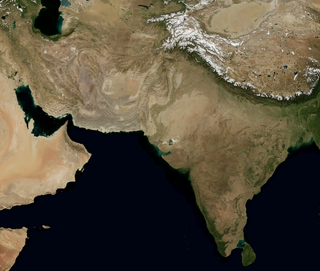
The Geography of Pakistan encompasses a wide variety of landscapes varying from plains to deserts, forests, and plateaus ranging from the coastal areas of the Indian Ocean in the south to the mountains of the Karakoram, Hindukush, Himalayas ranges in the north. Pakistan geologically overlaps both with the Indian and the Eurasian tectonic plates where its Sindh and Punjab provinces lie on the north-western corner of the Indian plate while Balochistan and most of Khyber Pakhtunkhwa lie within the Eurasian plate which mainly comprises the Iranian Plateau.

The Sulaiman Mountains, also known as Kōh-e Sulaymān or Da Kasē Ghrūna, are a north–south extension of the southern Hindu Kush mountain system in Pakistan and Afghanistan. They rise to form the eastern edge of the Iranian plateau. They are located in the Kandahar, Zabul and Paktia provinces of Afghanistan, and in Pakistan they extend over the northern part of Balochistan and Waziristan as well as Kurram of Khyber Pakhtunkhwa. In southwestern Punjab, the mountains extend into the two districts of Dera Ghazi Khan and Rajanpur, which are located west of the Indus River on the boundary with Balochistan. Bordering the mountains to the east are the plains of the Indus River valley, and to the north are the arid highlands of the Central Hindu Kush whose heights extend up to 3,383 metres (11,099 ft). The total area on which this range spans around 6475 sq. km .Together with the Kirthar Mountains on the border between Balochistan and Sindh, the Sulaiman Mountains form what is known as the Sulaiman-Kirthar geologic province.

Pinus gerardiana, commonly known as the chilghoza pine or neja, is a pine native to the northwestern Himalayas in Afghanistan, northern Pakistan, Waziristan and northwestern India, growing at elevations of 1,800–3,350 metres (5,910–10,990 ft). It often occurs in association with Cedrus deodara, and Pinus wallichiana.
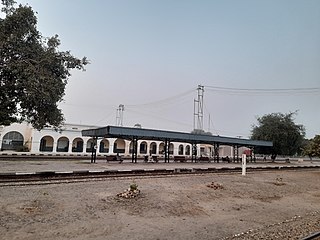
Chichawatni is a city in the Sahiwal District of the Punjab province of Pakistan. It is the administrative center of Chichawatni Tehsil. Situated near the old main road called Grand Trunk Road, it lies approximately 45 kilometres (28 mi) from the district capital, Sahiwal. In 2011, Chichawatni's population was estimated at 160,000.

Ayubia National Park, also known as Ayubia, is a protected area of 3,312 hectares (33 km2) located in Abbottabad District, Khyber Pakhtunkhwa province, Pakistan. It was declared a national park in 1984. Ayubia was named after Muhammad Ayub Khan (1958–1969), second President of Pakistan. The area supports temperate coniferous forest and temperate broadleaf and mixed forest ecoregion habitats, with an average elevation of 8,000 feet (2,400 m) above sea level. Ayubia National Park is surrounded by seven major villages and three small towns of Thandiani, Nathiagali and Khanspur. The park has been developed as a resort complex from a combination of four mini resorts of Khaira Gali, Changla Gali, Khanspur and Ghora Dhaka in Galyat. Currently, it is managed by the Wildlife and Parks Department of Government of Khyber Pakhtunkhwa.
Hazarganji Chiltan National Park is a national park in the Mastung District of western Balochistan Province of Pakistan. It lies between Chiltan on its west and Hazarganji on the east. The park was established in 1980 to provide the habitat to rare Chiltan ibexes found in the area.
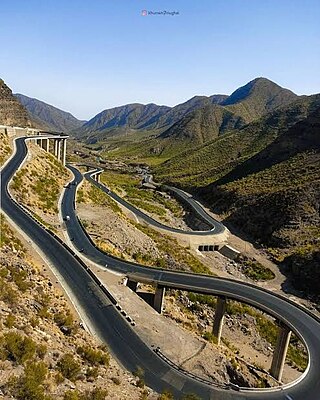
Fort Munro, formerly known as Tuman Leghari because of the Leghari tribe who was living here before the British came. It is a hill station which is located at a height of 6,470 feet (1,970 m) above sea level in Dera Ghazi Khan District of Punjab, Pakistan. Fort Munro or formerly 'Tuman leghari' is the head quarter of the Leghari tribe. Fort Munro is part of Sulaiman mountain range. It was developed by British in the late 19th-century as a summer hill town. The town was Named after commissioner Multan division Colonel Munro.
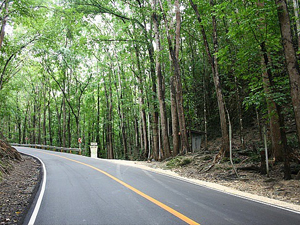
The Changa Manga is a planted forest which includes a wildlife preserve, in the Kasur and Lahore districts of Punjab, Pakistan. It is located approximately 80 kilometers south-west of Lahore. It was once the largest man-made forest in the world but has undergone illegal deforestation at a massive scale in recent times.

Forestry in India is a significant rural industry and a major environmental resource. India is one of the ten most forest-rich countries of the world. Together, India and 9 other countries account for 67 percent of the total forest area of the world. India's forest cover grew at 0.20% annually over 1990–2000, and has grown at the rate of 0.7% per year over 2000–2010, after decades where forest degradation was a matter of serious concern.

The wildlife of Pakistan comprises a diverse flora and fauna in a wide range of habitats from sea level to high elevation areas in the mountains, including 195 mammal, 668 bird species and more than 5000 species of Invertebrates. This diverse composition of the country's fauna is associated with its location in the transitional zone between two major zoogeographical regions, the Palearctic, and the Oriental. The northern regions of Pakistan, which include Khyber Pakhtunkhwa and Gilgit Baltistan include portions of two biodiversity hotspot, Mountains of Central Asia and Himalayas.

Pakistan's native fauna reflect its varied climatic zones. The northern Pakistan, which includes Khyber Pakhtunkhwa and Gilgit Baltistan, has portions of two biodiversity hotspots, Mountains of Central Asia and Himalayas.

Pakistan's native flora reflects its varied climatic zones, which range from arid and semi-arid to temperate and tropical.
Mizri Ghar at 3,111 metres (10,207 ft) is the third highest mountain in the Sulaiman Mountains of Western Pakistan. The only peaks higher are Qaisaghar (Kaisargarh) at 3,444 metres (11,299 ft) and Takht-i-Sulaiman at 3,378 metres (11,083 ft). Mizri Ghar is located in Sub-Tehsil Zimri Palaseen of District Musakhail, Balochistan. In summer, Mizri Ghar receives a high amount of rainfall while in winter season it receives a considerable amount of snowfall, sometimes 4 to 5 ft. Its climate is very cool even in summer and its temperature is comparable to Naran, Kaghan, and Murree. This climate uniqueness of Mizri Ghar makes it one of the coldest tourist points in Baluchistan and makes it attractive for the tourists of the adjoining areas such as Zhob, Loralai, D I Khan, DG Khan, and even Multan.

The Balochistanblack bear is a subspecies of the Asian black bear occurring in the Balochistan Mountains of southern Pakistan and Iran. It has an unusually thin coat for an Asian black bear, but this is because it is found in a warmer climate than most of the other subspecies, which are found in the much colder Himalayan Mountains. It is also more frugivorous than the other subspecies, and it loves to eat figs and bananas.

The topography of Pakistan is divided into seven geographic areas: the northern highlands, the Indus River plain, the desert areas, the Pothohar Plateau, Balochistan Plateau, Salt Range, and the Sistan Basin. All the rivers of Pakistan, i.e. Sindh, Ravi River, Chenab River, Jhelum River, and Sutlej River, originate from the Himalayas mountain range. Some geographers designate Plateau as to the west of the imaginary southwest line; and the Indus Plain lies to the east of that line.
Biosphere reserves are established according to the UNESCO's Man and the Biosphere Programme (MAB) to promote sustainable development for conservation of biological and cultural diversity. As of 2016, the Lal Suhanra Biosphere Reserve and Ziarat Juniper Forest are the only two biosphere reserve in Pakistan, which were approved by UNESCO in 1977 and 2013 respectively. A number of initiatives and projects have been undertaken to promote and develop other biosphere reserves in Pakistan but due to weak implementation this has not yet been materialized. In July 2012, Pakistan Museum of Natural History and Beijing Museum of Natural History signed a MoU to work on trans-boundary biodiversity and to improve MAB related activities in the Karakoram, Himalaya, and Hindukush regions.
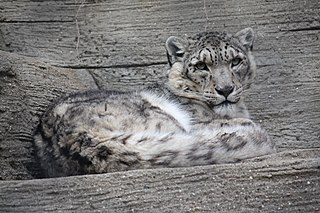
Conservation in Pakistan is the act of preserving, guarding, or protecting, biodiversity, environment, and natural resources of Pakistan.

The Ziarat Juniper Forest is a juniper forest in Ziarat, Balochistan, Pakistan.

The Baluchistan xeric woodlands ecoregion covers the middle elevations of a series of mountain ranges of western Pakistan and northeastern Afghanistan, reaching 1,200 kilometres (750 mi) from the Arabian Sea in the south to the Hindu Kush Mountains and the Himalayas in the north. The characteristic vegetation is xeric (dry) woodlands of shrubs and herbaceous cover. The region has rich biodiversity but relatively few endemic species.

Juniperus seravschanica is a species of juniper. Common names include Pashtun juniper.



















